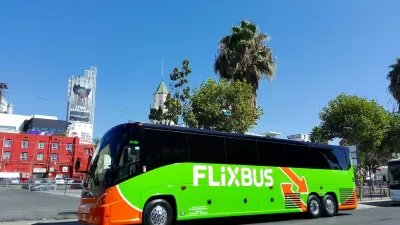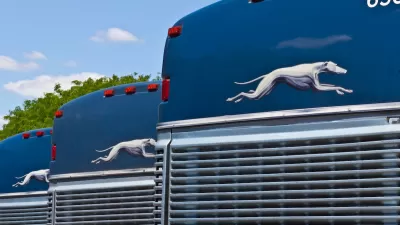As I began to type this, I was on a Greyhound bus somewhere in southern Ontario, on the first leg of my return from Toronto (where I have spent the past year getting an extra degree) to the United States. As I type, it occurs to me to ask myself: what are the interests of the long-distance bus rider? Are they the same as users of other forms of public transit, or closer to those of drivers and truckers? My short answer to these questions is: a little of both.
As
I began to type this, I was on a Greyhound bus somewhere in southern Ontario,
on the first leg of my return from Toronto (where I have spent the past
year getting an extra
degree) to the United States.
As I type, it occurs to me to ask
myself: what are the interests of the long-distance bus rider? Are
they the same as users of other forms of
public transit, or closer to those of drivers and truckers? My short
answer to these questions is: a little of both.
First
of all, a bus rider needs good roads: smooth roads that enable him/her
to read
or type without being jolted by stomach-churning bumps. In
this respect, a bus rider is like a
motorist: motorists also value good roads rather than pothole-filled
obstacle
courses.
And certainly a bus
rider places some value on lack of
congestion, though probably less than a motorist. In a bus, I don't
expect a
total free flow of traffic, but I do mind congestion sufficiently severe
to
create enormous delays. Although all bus riders
value on-time performance, I think this is probably somewhat more true
for
long-distance bus riders than for riders of municipal buses, since the
former
group is more likely to be stuck on interstate highways where there is
no escape
from congestion. (By contrast, if a bus on a downtown street is moving
too
slowly for your taste, you might be able to get off the bus and start walking to
your
destination).*
But in other respects, long-distance
bus riders and municipal bus riders are like pedestrians and users of
rail
transit. For example, even intercity bus riders value public transit, so that once
they
get in their destination city they can reach a wide variety of destinations within the city.
And ideally, the bus station should be in a walkable area well served by public transit. When I ride a long-distance
bus, I want my bus station to be in a busy neighbourhood where I can
walk to
something interesting if I have some spare time. For
example, Toronto's bus station is quite centrally
located, which means I can walk to an enormous variety of destinations.
But in other cities, this is not the case. For example, I was recently
on a bus that stopped at the South Bend, Indiana, airport, which
appeared to be near absolutely nothing. (After checking walkscore.com, I
found that its Walkscore was 11). When I visited Chattanooga some years ago, I noticed that its bus station (also near the airport) is a few blocks away from not only the nearest city bus, but even the nearest sidewalk.
Other bus stations are in truly
scary neighborhoods; St. Louis's bus station appeared to be in one of
the city's large stock of deserted areas. In my experience, this is a
"smart growth vs. sprawl" issue: the most transit and
pedestrian-oriented cities tend to have bus stations closer to downtown,
while declining or sprawling cities tend to have bus stations in less
impressive places. **
*Depending
on how
able-bodied you are, the degree of hurry you are in, and numerous other
variables.
**However, there are plenty of exceptions to this
generalization. For example, Jacksonville's bus station is pretty close to the heart of downtown.

Manufactured Crisis: Losing the Nation’s Largest Source of Unsubsidized Affordable Housing
Manufactured housing communities have long been an affordable housing option for millions of people living in the U.S., but that affordability is disappearing rapidly. How did we get here?

Americans May Be Stuck — But Why?
Americans are moving a lot less than they once did, and that is a problem. While Yoni Applebaum, in his highly-publicized article Stuck, gets the reasons badly wrong, it's still important to ask: why are we moving so much less than before?

Research Shows More Roads = More Driving
A national study shows, once again, that increasing road supply induces additional vehicle travel, particularly over the long run.

Judge Halts Enforcement of Anti-Homeless Laws in Grants Pass
The Oregon city will be barred from enforcing two ordinances that prosecute unhoused residents until it increases capacity and accessibility at designated camping sites.

Advancing Sustainability in Los Angeles County Schools
The Los Angeles County Office of Education’s Green Schools Symposium brings together educators, students, and experts to advance sustainability in schools through innovative design, climate resilience strategies, and collaborative learning.

Using Old Oil and Gas Wells for Green Energy Storage
Penn State researchers have found that repurposing abandoned oil and gas wells for geothermal-assisted compressed-air energy storage can boost efficiency, reduce environmental risks, and support clean energy and job transitions.
Urban Design for Planners 1: Software Tools
This six-course series explores essential urban design concepts using open source software and equips planners with the tools they need to participate fully in the urban design process.
Planning for Universal Design
Learn the tools for implementing Universal Design in planning regulations.
City of Moreno Valley
Institute for Housing and Urban Development Studies (IHS)
City of Grandview
Harvard GSD Executive Education
NYU Wagner Graduate School of Public Service
City of Cambridge, Maryland
Newport County Development Council: Connect Greater Newport






























